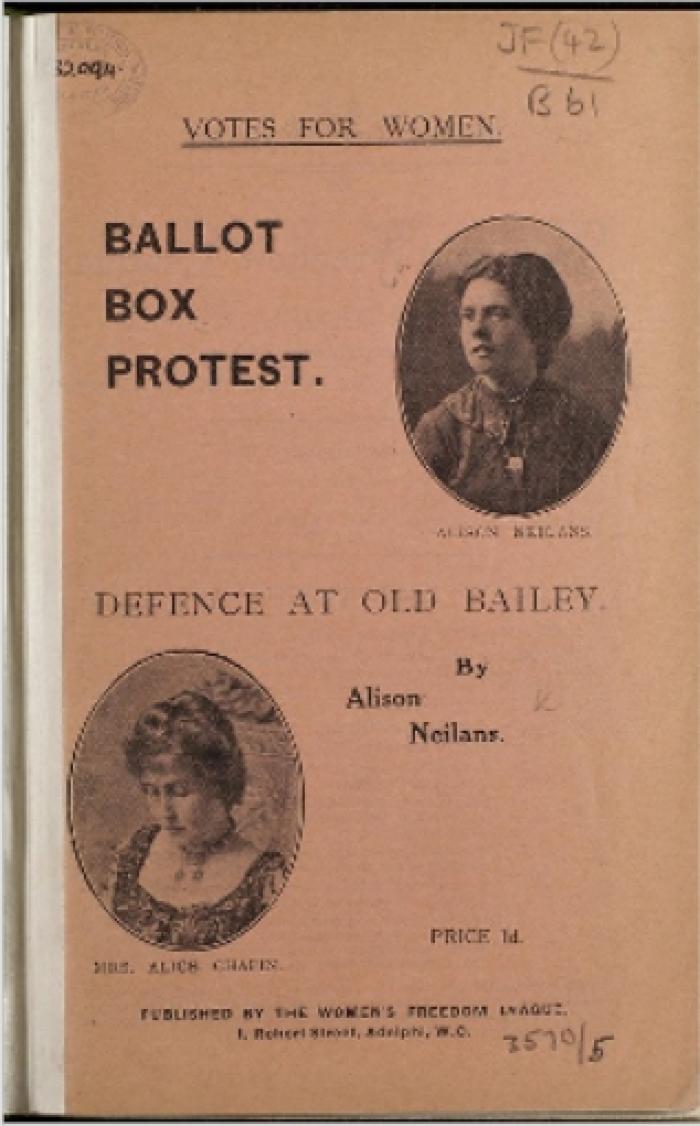Alison Neilans
Born East Dulwich 19 June 1884
Died 17 July 1942 in HGS

Born into a middle class family, her father died when she was aged 12, and she was obliged to work as a bookkeeper.
She joined the Women's Freedom League (WFL) in 1908 and soon became the financial secretary. She was also involved in recruitment campaigns around the country.
She quickly became a member of the executive committee of the Women's Freedom League. This would have brought her into contact with Suburb residents Edith How Martyn and Bessie Drysdale who were both founding members of the WFL and were on the Executive at this time.
Alison Neilans was also a member of the Church League for Women's Suffrage and the East London Federation of Suffragettes, where she worked with Sylvia Pankhurst. (Other members included Keir Hardie, Millie Lansbury, and George Lansbury).
She was also a member of the board of the International Woman Suffrage Alliance. In 1926 she was a delegate at the International Alliance of Women for Suffrage and Equal Citizenship.
Neilans was imprisoned three times for her activities. In 1908 she was imprisoned twice. On the first occasion she and others were arrested for demonstrating outside the London home of a cabinet minister. She was also arrested at a demonstration outside parliament. In both cases she was imprisoned for one month in Holloway when she refused to pay the fine.
The best-known event involving her was an attempt to vandalise ballot papers during the Bermondsey by-election. She and Alice Chapin spoilt ballot papers by pouring liquid into ballot boxes. Chapin was successful in damaging many ballot papers, and Neilans damaged a few. All of the ballot papers still were readable and the election was unaffected. However, a polling official was injured and both women were sent for trial and subsequently imprisoned for three months, in 1909.
George Thorley, the presiding officer, had chemicals splashed in his eye. At the trial, the doctors said that Thorley may have a haze over his eyes for life. The suffragettes believed that Thorley had exaggerated his injury and that the damage was caused to his applying ammonia after the incident in a panicked attempt to alleviate damage.
Chapin and Neilans were tried at the Old Bailey, and Neilans later published an account of their defence. The account of the trial of Alison Neilans was written by Alison Neilans and published by the WFL. Chapin was given a longer sentence than Neilans, but she was released two days after her under the "King's Pardon".

Neilans went on hunger-strike and was forced-fed. When the doctors entered her cell they had given her the choice of weapons - nasal tube, stomach tube, or feeding-cup. Which did she prefer? Although she heard the stomach-tube operation was the most dangerous, she chose this method in preference to the nasal feeding. She was held down in the chair by two women, their fingers were forced between her teeth, her head thrown back, the tube was gradually forced down her throat, and the feeding commenced. Although she did not go so far as to describe the operation as torture, she did say it was the most unspeakable outrage that could be offered to anyone.
Neilan’s release was reported in The Vote (The WFL newspaper); ‘The gates opened at last, and swinging down the yard came Alison, a little thinner, but brave and young and dauntless, with the light of battle in her eyes. ‘I’m keener than ever’ was her greeting’.
Neilans was a frequent speaker across the country for the WFL. She also spoke in support of related campaigns, including in Hampstead Garden Suburb where she was living from 1912. In April 1913, she spoke at an open-air meeting of the Women’s Tax Resistance League in Temple Fortune Lane. At this meeting, Alison argued that there should be ‘no taxation without representation’ and said that the refusal of the government to extend the franchise meant that “women were, no better off than criminals or lunatics”. During this meeting she was asked about the suffragette arson campaign in the Suburb and said that it was doing the cause of women’s suffrage ‘no good’.
In August 1913, Neilans was the speaker for the daily meetings of the Women's Freedom League 'Clyde Coast Campaign', which included Rothesay, Largs and Dunoon.
In 1915 she became Secretary of the Association for Social and Moral Hygiene which advocated on issues around sexually transmitted diseases, trafficking and prostitution.
All portrait pictures of Neilans show her wearing the WFL prisoner medal.
Return to Other suffragists and suffragettes here